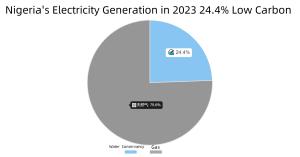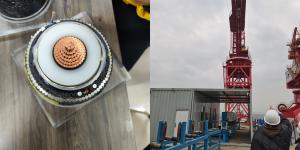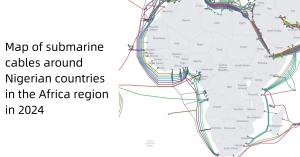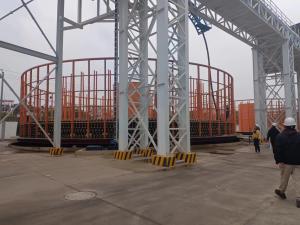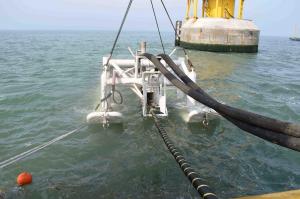ZMS Cables Successfully Completes Submarine Cable Project with Nigeria
The transmission license was granted on July 1, 2006, for high voltage transmission, national grid operations, and market operations services.
Currently, Nigeria's national grid consists of generation, distribution, and transmission companies, and the transmission lines within its territory are under the sole responsibility of TCN, the government-controlled Transmission Company of Nigeria (TCN).ZMS is honored to work on the submarine cable transmission line project with such a deep-rooted power utility.
TCN's Founding Development and Current Status
In the decades since Nigeria's independence, the country's population has grown by about 160 million people, but the lack of corresponding growth in energy supply, coupled with the severely uneven distribution of electricity in the country, has prevented the simultaneous development of many heavy industries and amenities, resulting in the country's GDP levels and the daily lives of its inhabitants being affected. One of the most affected areas is electricity, the normal transmission of which is fundamental to a country's economic development.
Based on the fact that the current level of power in the country could not meet the growing economic and infrastructural development goals, the Federal Government of Nigeria realized the need to split the defunct National Electric Power Authority (NEPA) into small but efficient units, as adequate and efficient power is a major factor in modern industrial development. This led to the establishment of TCN.
Since its inception, TCN's main responsibility has been the transmission of medium voltage and high voltage lines within the country, including power signaling. The main business operations of TCN are as follows:
- Operation, expansion/upgrading of transmission facilities for efficient and effective transmission of power generation.
- Creating transmission grids that allow for the efficient evacuation of all generations.
- Create sufficient network redundancy to ensure at least 99.9% reliability.
- Reduce transmission losses to less than 5%.
Status of Cable Development in Nigeria
The Nigeria electricity market size in terms of Equal-4.28 is projected to grow from USD 391.69 million in 2024 to USD 483.00 million by 2029, at a CAGR of 4.28% during the forecast period (2024-2029).
- In the medium term, increasing demand for energy due to increasing industrialization and urbanization activities and penetration of renewable energy sources is expected to drive the market over the forecast period.
- However, costs associated with increasing infrastructure for power generation facilities are expected to hamper the growth of the power market.
- Nonetheless, Distributed Generation (DPG) presents significant opportunities for the Nigerian power market.
The above is a new model of power generation being experimented with by the Nigerian government, and there is data to suggest that it will go a long way in improving the uneven distribution of all power within the country.
Source: https://www.mordorintelligence.com/zh-CN/industry-reports/nigeria-power-market
Nigeria is one of the largest economies in the African continent with a GDP of about $440.78 billion in 2021. However, the performance of the country's power sector is significantly lower than that of other countries. As of 2021, about 40% of the population still does not have regular access to grid-connected electricity, with grid-connected areas often suffering from widespread blackouts.
- Thermal power generation is one of the major sources of electricity generation in the country. The country's vast natural gas potential is expected to contribute to the growth of thermal energy in the medium term.
- As the government aims to address the country's energy crisis, natural gas has emerged as the preferred source of energy due to its high efficiency in power generation, relatively low unit cost, and low carbon emissions. As a result, the country has been relying on natural gas as the primary fuel for energy production, with other sources playing a secondary role.
- For instance, in March 2023, a 50 MW gas-fired power plant was commissioned in the Maiduguri area to provide electricity to the residents of the area.
In addition, as Nigeria's population continues to grow, so does the country's demand for electricity. To meet these demands, the government expects to increase the deployment of thermal energy sources because of their relatively low construction and operating costs.
ZMS's Partnership with TCN
ZMS has partnered with TCN on this project for submarine transmission lines. Submarine communication transmission lines are mainly used for long-distance communication networks, usually between long-distance islands, cross-sea military installations, and other more important occasions. Submarine power cables are laid over much shorter distances than telecommunication cables, and are mainly used between land islands, across rivers or harbors, and to connect drilling platforms or interconnect drilling platforms from land. The development of submarine transmission lines in Nigeria, with its geographical advantage of being bordered by the Gulf of Guinea to the south, will greatly enhance the country's local communications, power, and economic levels.
Project Name: Osogbo/Olorunsogo 132kV Submarine Transmission Line
The main cable product of this deal is a 132kV high-voltage submarine cable, which is intended to strengthen the local high-voltage transmission network in Nigeria.
Nigeria is located in the West African region and is not a submarine cable drought area, as early as more than a decade ago, there have been a variety of communications and power companies to develop the coast of submarine cable communications. At present, the entire West African region has some submarine cables, so many countries on the submarine cable have sufficient installation experience and maintenance capacity.
For example, on March 14 this year, on the west coast of Africa near Côte d'Ivoire and Senegal undersea fiber optic cables occurred in several breaks, resulting in many countries in West Africa, where data and voice services have been seriously affected. The West African Submarine Cable System (WACS), the Africa-Europe Submarine Optical Cable System (ACE), the South Atlantic 3 (SAT3), and MainOne cables were all reported to have experienced failures or disruptions.
Faced with the crisis, telecom operators in the region responded quickly by utilizing submarine cable capacity not affected by the fiber optic cable cuts, activating alternate connectivity options, and making every effort to repair the situation. Within days, however, the affected voice and data services were restored to near-normal levels.
As critical infrastructure for the Internet in Africa, submarine cables' safety and stability are paramount. The accident has once again highlighted the necessity of diversifying the layout of submarine cables. Stella Lo layer of Hong Kong IDC New Horizon Interconnection pointed out that when choosing Internet service providers (ISPs), African enterprises should focus on the status of their infrastructure, including international bandwidth providers, the number of submarine cable networks accessed, and whether they have automatic switching functions.
According to ZMS staff, although the disruption of the submarine cable has caused a huge impact on the banking, telecommunications, currency transfer, and securities trading industries in West African countries, many enterprises and individual users have reported slow or even interrupted network connections, which has brought a lot of inconvenience to their daily work and life.
But the good news is that through the joint efforts of all parties, positive progress has been made in the restoration work. operators such as Seacom and Liquid said that thanks to the previous investment in the layout of several submarine cables on the east and west coasts, they have been able to minimize the impact of the incident and provide stable services to their customers.
So ZMS and TCN Power are very confident in this cooperation of high voltage submarine cable transmission project. Submarine cable, as the carrier of submarine power transmission and fiber optic signal transmission, has strict requirements on its production equipment and product structure, ZMS has been working in the field of submarine cables for many years and has already sold 53.8km of submarine cables, which have helped many islands or regions to realize the power and network. In this project, ZMS was involved in the structural design, packaging, and transportation of the submarine cable and provided advice during the installation and construction.
Recent Developments in Submarine Cables
With the rapid advancement of the global digitalization process, and digital applications to promote the rise in demand for data centers, the data center construction boom continues, and the global submarine cable construction scale of high-speed growth. At the same time, the development of marine oil and gas resources, submarine observation network construction, and other submarine cable open up new application scenarios. Submarine cable technology has made great progress, multi-fiber pairs of cable, ultra-high-speed single-wave rate, and ultra-high voltage remote power supply technology began to promote the application.
Internet giants have triggered the adjustment of the global submarine cable development pattern, and the participation of multiple subjects has given rise to a variety of construction modes, with the rapid development of submarine cable general contracting, equipment manufacturing, survey, construction and maintenance, and other industry segments. To better integrate into the wave of global digital economy development and share the opportunities of global digital economy development, relevant countries have optimized the policy environment, accelerated the construction of submarine cable and other international communication facilities, and boosted the development of the submarine cable industry.
Reference: http://www.caict.ac.cn/kxyj/qwfb/ztbg/202307/P020230718390842938808.pdf
ZMS's Viewpoint
In the view of the cable industry, the development and production of submarine cables will still grow rapidly in the next decade or so, because submarine cables not only carry the transmission of electricity but also are responsible for the important transmission of communication and financial transactions between two countries or regions. While the maintenance and repair of submarine cables is still a high cost for many countries, the benefits they bring after they are built are much more important.
In the future, factors such as global economic fluctuations, continuous upgrading of submarine cable technology, and changes in cross-border data flow rules will not affect the global submarine cable construction process. With the continued advancement of global digitalization and the increasing demand for intra- and inter-regional connectivity, the submarine cable industry will continue to maintain rapid development.
ZMS Cable
ZMS Cable
+ +86 37167829333
email us here
Visit us on social media:
Facebook
Twitter
LinkedIn
YouTube
Other
160 Years ago, The World's First Transoceanic Submarine Cable
Legal Disclaimer:
EIN Presswire provides this news content "as is" without warranty of any kind. We do not accept any responsibility or liability for the accuracy, content, images, videos, licenses, completeness, legality, or reliability of the information contained in this article. If you have any complaints or copyright issues related to this article, kindly contact the author above.

